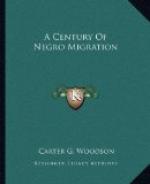The enslavement of the black man by the whites in this section dates from the early part of the eighteenth century. Being a part of the Louisiana Territory which under France extended over the whole Mississippi Valley as far as the Allegheny mountains, it was governed by the same colonial regulations.[9] Slavery, therefore, had legal standing in this territory. When Antoine Crozat, upon being placed in control of Louisiana, was authorized to begin a traffic in slaves, Crozat himself did nothing to carry out his plan. But in 1717 when the control of the colony was transferred to the Compagnie de l’Occident steps were taken toward the importation of slaves. In 1719, when 500 Guinea Negroes were brought over to serve in Lower Louisiana, Philip Francis Renault imported 500 other bondsmen into Upper Louisiana or what was later included in the Northwest Territory. Slavery then became more and more extensive until by 1750 there were along the Mississippi five settlements of slaves, Kaskaskia, Kaokia, Fort Chartres, St. Phillipe and Prairie du Rocher.[10] In 1763 Negroes were relatively numerous in the Northwest Territory but when this section that year was transferred to the British the number was diminished by the action of those Frenchmen who, unwilling to become subjects of Great Britain, moved from the territory.[11] There was no material increase in the slave population thereafter until the end of the eighteenth century when some Negroes came from the original thirteen.
The Ordinance of 1787 did not disturb the relation of slave and master. Some pioneers thought that the sixth article exterminated slavery there; others contended that it did not. The latter believed that such expressions in the Ordinance of 1787 as the “free inhabitants” and the “free male inhabitants of full size” implied the continuance of slavery and others found ground for its perpetuation in that clause of the Ordinance which allowed the people of the territory to adopt the constitution and laws of any one of the thirteen States. Students of law saw protection for slavery in Jay’s treaty which guaranteed to the settlers their property of all kinds.[12] When, therefore, the slave question came up in the Northwest Territory about the close of the eighteenth century, there were three classes of slaves: first, those who were in servitude to French owners previous to the cession of the Territory to England and were still claimed as property in the possession of which the owners were protected under the treaty of 1763; second, those who were held by British owners at the time of Jay’s treaty and claimed afterward as property under its protection; and third, those who, since the Territory had been controlled by the United States, had been brought from the commonwealths in which slavery was allowed.[13] Freedom, however, was recognized as the ultimate status of the Negro in that territory.




